Women in Service
WW1
Photograph of San Francisco Yeomen Attached to the Naval Reserve;
Even with thousands of volunteers, the US Navy was shorthanded in WW1. The number of US ships increased from 300 to 1,000 and the demand for personnel was intense. Prior to 1916 women were prohibited from joining any of the armed forces. The Naval Act of 1916 also called the "Big Navy Act" called for a large increase in the US Navy, was in response to the war in Europe. President Wilson expressed an intention to build "incomparably, the greatest Navy in the world" with an eye to German aggression. The Naval Act was to be a ten-year program and increase the Navy ships over three years by adding:
- 10 Battleships
- 6 Battle Cruisers
- 30 Submarines
- 50 Destroyers
$500,000,000 was allocated. The goal was to protect the shores and merchant fleets.
The Naval Act of 1916 did not prohibit women.
Yeomen (F) was the designation for female Yoeman
The demand for Naval personnel was met by the inclusion of women. They could be "utilized as radio operators, stenographers, nurses, messengers, chauffeurs, etc. and in many other capacities in the industrial line."
As the war progressed women worked as mechanics, truck drivers, telephone operators, truck drivers, and munitions makers. Thousands of women served in the US Army and Navy Nursing Corps. Red Cross nurses served as well the Salvation Army, but women doctors were rejected from the Medical Corps. The Red Cross accepted Women as doctors and they served overseas.
Women Yoemen enlisted for the standard four years. In 1918 the Navy stopped enrolling women.
WWI Yeowomen, Bush Terminal, Brooklyn, NY
National Archives Photo, Indiana War Memorial
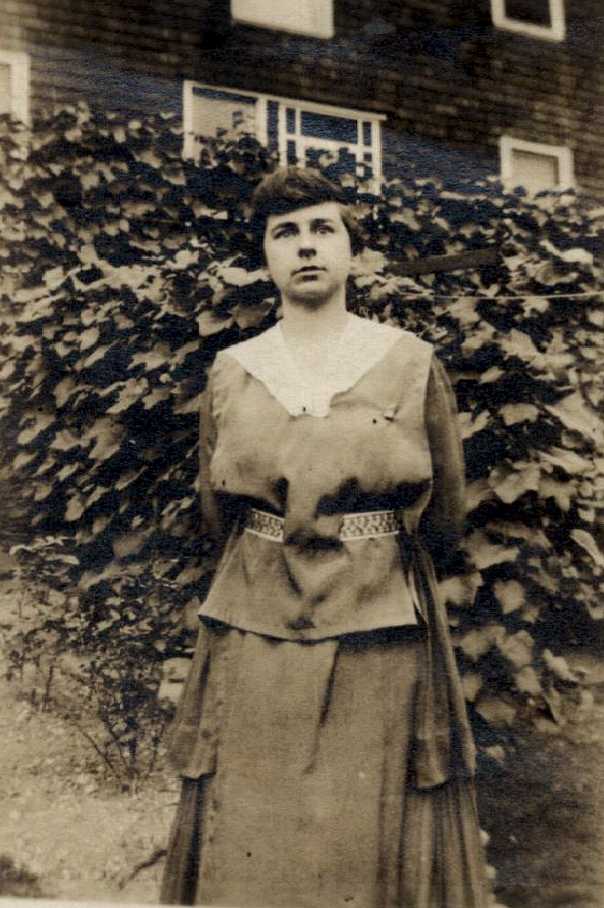
Grace Banker, supervisor of 32 "Hello Girls" in France.
Awarded the Distinguished Service Medal for her service
Photo courtesy of the National Archives, St. Louis,
Official Personnel Folder, War Dept.
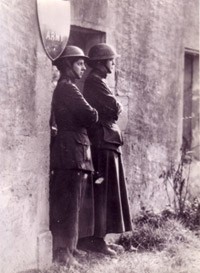
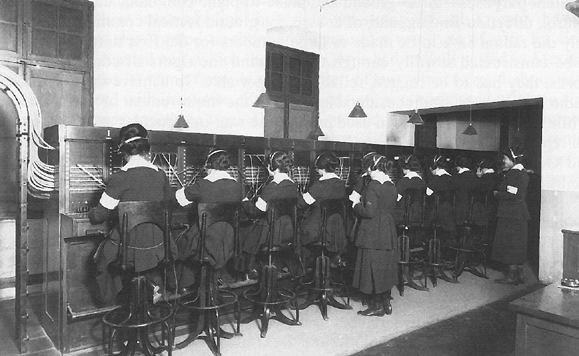
Hello Girls operating switchboards in Chaumont, France during WWI
Army Signal Corps Photo #: SC-33446 (Wikipedia)
General John J Pershing called for the creation of the Signal Corps comprised of female telephone operators. The women who served were bilingual in English and French and were given physical training and had to observe strict military protocol. They worked near the front lines. and became known for their bravery and focus.
Excerpt from the VFW magazine:
"Gen. Pershing apparently observed the effectiveness of Britain's Women's Army Auxiliary Corps with maintaining pristine phone communications. The communications situation in France upon the arrival of the first contingency of American forces paled in comparison. The French women were not trained in any English and the phone lines were constantly being compromised by artillery and bombings.
In March 1918 the first contingent of Hello Girls, compromising mostly of Louisiana Creoles for their ability to speak French, arrived in France. They exhibited extraordinary courage during the Battle of Meuse-Argonne. German shrapnel destroyed the windows of the central phone exchange. Despite the bitter cold, the Hello Girls continued to maintain impeccable performance contributing to the Allied victory. It was not until 1979, when 31 surviving Hello Girls received their WWI Victory Medals under President Carter. Originally, there were more than 200 American women who served as these civilian telephone operators, two of whom died of the Spanish flu while serving in France."
Salvation Army Workers in France
Indiana War Memorials Photo
See: https://wwvets.org/veterans-of-world-war-1/salvation-army-and-ymca/
Stories from Women who served
Mrs. Mary R. Noble
Nurse, WWI & WWII
Marion County, Indiana,
"She did not intend to paint a romantic picture of such service. Instead, she told of pain and untold suffering and the parallel of 1918 and 1940 was clearly drawn.
"Came the time," she said, "when the whole allied line fell back before the German army. This was the beginning of the great retreat of 1918. First came the gas cases. The hospital filled up with them and they died like flies. They were pitifully burned and many were completely blinded."
"Every hut and marquee was filled to overflowing with them, coughing and gasping. All hours of the day and night they died. One man came in with his entire jaw shot off. It was a fearful sight. He wrote on a slip of paper "I am a minister, will there be any chance of getting me home?"
"One little boy came in, a walking case when he should have been on a stretcher. His arm was shattered to pieces. He had a pair of army boots, a pair of pajamas, a steel helmet, and an army blanket around his shoulders. One man came in, a basket case with neither arms nor legs."
"We dressed their wounds and sent them off by ambulance to the hospital ships – and still they came. We were told that the German army was now within a comparatively few miles. Thirty thousand wounded came through Rouen in ten days and every man received treatment. Then the German Army was halted and it was its turn to retreat, and the American army was now in action."
Mary P. Kappes
Marion County, Indiana
American Red Cross
"My impression of war during and after is of its utter futility and stupid uselessness. When I was at the Children's Bureau in Leon I was told to start a diary, which I did with the help of very able Quakers. Several months later the head of the Bureau took me to task: 'I see you have the sale of a calf indicated on your report. Who authorized you to buy a calf?' I could only answer, 'The Lord provided'."
Mabel West
Occupational Therapist
Marshall County, Indiana
"Busiest and most useful period of my life. I was in touch with men from every state in the country and from every walk of life... Think of going down Chesapeake Bay in a large hospital boat with 1000 wounded men on board."
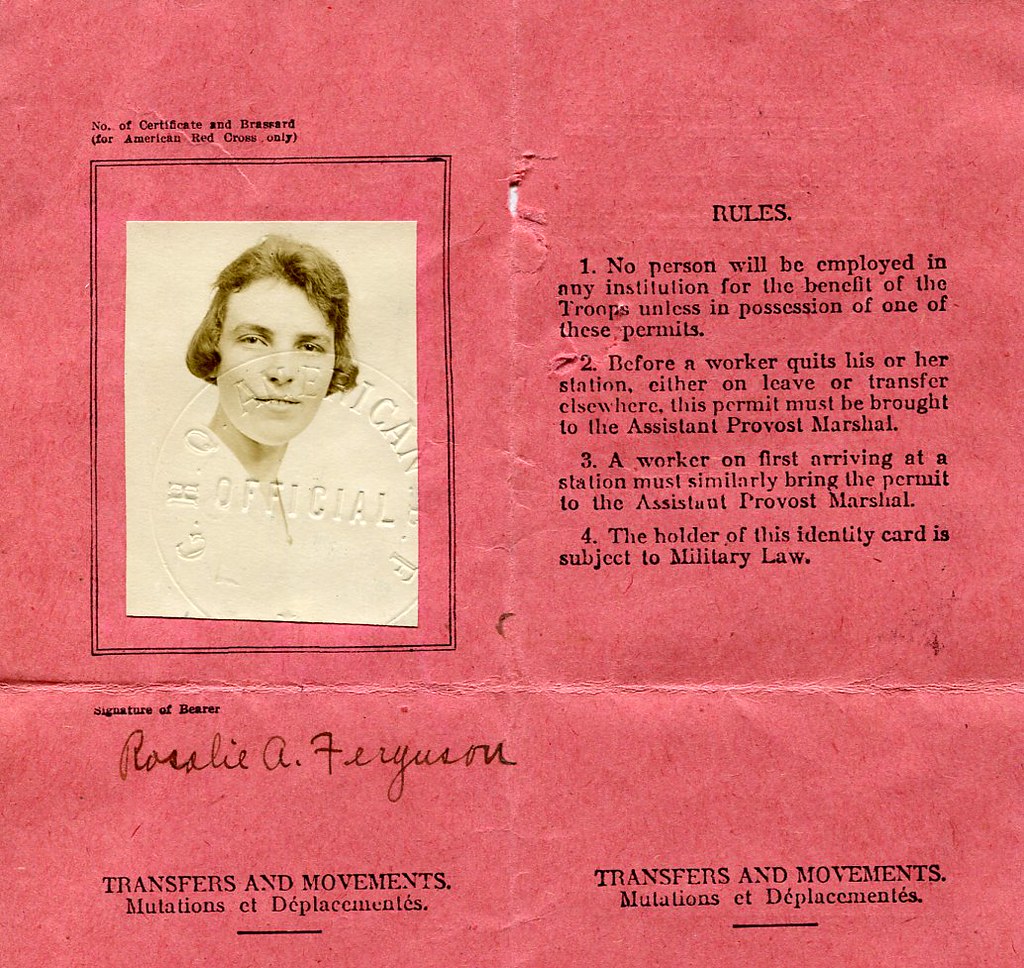
Rosalie A. Ferguson’s original American Expeditionary Forces military nurse pass for France in January 1919, with her official studio portrait. US Army Signal Corps
Jesse Marlette
Dubois County, Indiana
American Red Cross
"The willingness of sacrifice that within each and every heart."
Mabel Lenora Orner
Jay County, Indiana
Army Nurse Corps
"I am glad for the experience I had in the service. I made some lasting friendships. But I sincerely hope we do not have another war.
Etta M. Owens,
Warrick County, Indiana
Army Nurse Corps
"Very interesting. Nerve-racking."
Gertrude Elizabeth Sims
Wayne County, Indiana
American Red Cross Relief Worker
" In Paris, I formed a number of close and lasting friendships with young French women, still in correspondence with most of them. They were all lovable and hospitable, and in fundamentals, exactly like Americans. My time over there deepened my convictions that all war is wrong and futile".
Hazel Anne Dickens
American Red Cross
Grant County, Indiana
"My impressions of Paris during the war are still a confusing jumble of marching in, wounded and dying in hospitals, widows and orphans, bright military pageants, sessions of hard work that often carried far into the night, dances in Army camps, 'Y' Huts, etc., but overall the shadow of death. I have a vivid picture of courage and loyalty, smiles and tears, and the ability to carry on under the most trying conditions that could be created, a World War. I met some of the characters who are forces of the war: 'Papa' Joffre, Gen. Pershing, Lloyd George, Mr. and Mrs. Herbert Hoover ( then working in Belgium), R. E. Olds ( later a member of the Cabinet), Ernest P Bicknell, Commissioner for France ( and Indiana man), Pres. Wilson. One of my most vivid remembrances is of a mid-Lenten fete in 1919, in Lille, where our warehouse was located, when we gave out to 8000 orphans bundles containing sweaters, handkerchiefs, Holmes, cookies, and candy. None of the children had tasted sugar or sweets for four years."
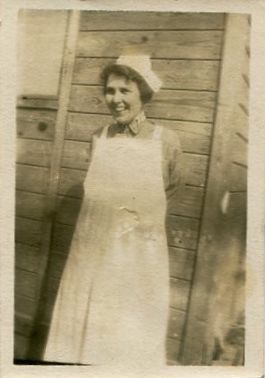
Margaret Hamilton
Nurse
British Expeditionary Unit
Marion County, Indiana
In memoriam; Ms. Margaret Hamilton, a graduate of the Protestant Deaconess Hospital training school for nurses, class of 1908, was one of 75 nurses who went to France with the Chicago unit, as part of the British expeditionary force. The unit sailed from New York, June 12, 1915 and took over a line of communication hospitals of 1000 beds about 40 miles back of the firing line. It is said that her quiet, skillful, tender and sympathetic care of the wounded Tommies was such that, as one man expressed it, it made them lose their patriotism so much that they never wanted to go back to the front... no finer tribute could be given to anyone than that paid by major George PDL of the Chicago unit, which follows in part; 'on October 25, 1915, a dark cloud of sorrow enveloped our camp. One of our nursing sisters, Ms. Margaret Hamilton, most capable, conscientious, and universally loved and respected, contracted meningitis while on duty and died within 36 hours. Aided by the British representatives, we try to make arrangements to send her body back to America, but under existing conditions it was impossible. She was given a military funeral with full honor and was buried in the officer section of the British military graveyard. The casket was borne on a two-wheeled carriage, preceded by the Chaplain and four trumpeters, accompanied by senior officers of the unit acting as pallbearers, and followed by the personnel of the unit, the nursing staff, and many others. Every hospital in the district was represented.
Viola May Burleson
Nurse
Posey County, Indiana
Served in France and Germany "A mixture of sadness, horror, and joy. Sadness that so many young men should have to go out to die before they really had a chance to live. The horror of seeing humanity slaughter each other. The joy of being young and able to do my bit."
Ahah McMahan, M.D.,
Dubois County, Indiana
Served at Cempuis; relief work at Epinal, France with Ambulance Z1-186. "Rather devastating, as I was only 45 miles from the front lines.... many incidents in relief work were amusing, probably because of my inadequate French... Interesting to visit Joan of Arc's birthplace.
Snapshot of U.S. Army Nurse Corps nurse Rosalie A. Ferguson of Silver City and Kinston, N.C., wearing a white nurse’s apron, laughing as she is standing outside at the corner of a building at the U.S. Army’s Base Hospital No. 65 in Kerhuon, France, during World War I. Caption on back of photograph is partially missing and unreadable [circa 1918]. US Army Signal Corps photo
Mary Agnes Goldthwaite, Nurse, Grant County, Indiana
At the time base hospital #18 was installed, there were no American base hospitals farther forward, and nearly until the end of the war, this hospital was the most advanced base hospital serving the American forces in the Toul and Nancy sectors.
Base Hospital #18 was organized on the old tables of strength, which were designed to supply personnel for a base hospital with 500 beds. The same formula was used for a hospital that actually had 1,000 beds and which was enlarged by a tent expansion, to a possible 1,300 beds. No corresponding change in its strength of staff was ever made. With the beginning of the active and intensive engagements of large military movements of the American Army in the latter part of May, the strength of the hospital was further reduced by the temporary detachment of surgical teams to various forward areas, to help in handling the vast flow of casualties resulting from the increased military activity. The enthusiastic, unveiling, and intelligent service rendered by the entire staff of doctors, nurses, and enlisted men will always be a source of undying satisfaction to all who were privileged to witness and have an interest in pride in the achievements of Base Hospital #18 at heart.
"The unfailing courtesy and good humor of the American soldier was seen everywhere. They came into hospitals, dirty, tired, wounded or ill, ready to smile, jive a comrade, to sing, to help to make the best of an unfortunate situation.. it was an experience I would not give up - and I would go again if necessary, but I sincerely hope that it will never be. For, on the whole, war is just like Gen. Sherman so aptly stated it to be.
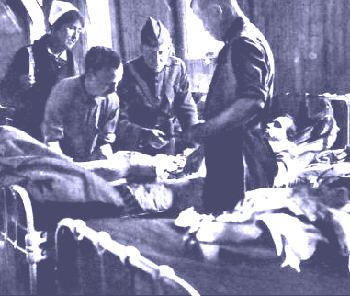
Gladys Grace Cline, YMCA, Marion County, Indiana
Served in Norway, Sweden, Finland & Latvia. "Tense days in a rapidly changing world.... because our passports read that our destination was Archangel Russia, an under official in Oslo (then Christiana) insisted that we take the next boat to Archangel, regardless of the fact that the American troops had just evacuated. There would not be another boat for five months because of the winter freeze.
Leah Graves, Quartermaster Corps, France, Orange County, Indiana
General Pershing cabled for US women to be sent to France to take the place of men in clerical work so they might be relieved for duty in the field. Only four units, or about 65 women, actually arrived in France for this work before the armistice was signed.
Lela Josephine Hauger, American Red Cross, Orange County, Indiana
American Red Cross, commission to Europe. Had previously applied for overseas work in Cleveland Ohio, but was refused because she had two German grandfather's. Served in Paris, France and Geneva, Switzerland. She was a member of the last Red Cross unit to sail for France. Served with Deputy Controller for European Commission; with Sales & Liquidation Board, handling sale of salable articles and allocating unsalables to various hospitals and civilian undertakings in Europe; helped install financial system for league of Red Cross Societies, Geneva, Switzerland. After discharge she served as an instructor in the Surgical Dressings Room, Indianapolis American Red Cross chapter and House Chairman for Red Cross Women's Club with the prime objective of the housing and care of Red Cross workers (often open to all war workers in Washington). Served as chairman of Walter Reed Hospital committee which planned entertainment for wounded men from hospitals; served as a chaperone for weekly dances at the Red Cross Convalescent Hut at Walter Reed hospital.

Florence J. Martin
Army Nurse Corps
Clark County, Indiana (Also listed under Medical Corps)
Awarded the Medaille d'Honneur des Epidemics by the Minister of War, France.
The Medal of Honor, Epidemics is rewarded to those who had particularly distinguished themselves by their dedication during periods of epidemic diseases:
- Exposed to dangers of contamination, providing care to patients with contagious diseases;
- Preserving, in a personal and noteworthy, territory or place of the invasion of a disease epidemic;
- Helping to spread or participating in disinfection operations, during an epidemic
See: http://www.themedalhound.com/frenchmoh/
See Base Hospital 32
Hazel Fern Bennett,
Nurse,
Rush County, Indiana
Too serious to be amusing. While with the French evacuation hospital things got so serious we had to evacuate our patients down the river on a boat to Conflant. While with Evacuation 7, we received a citation; also one while with the French.
Zona M Carrouthers (Parsons),
Nurse,
Shelby County, Indiana
Served at the Base Hospital in Camp Mills, NY. "Grateful to serve, for nurses were very much needed."
Rhuie D. Caster,
Nurse
Jay County, Indiana
Hard to give a definite idea of my impressions of the war period, because as a whole it still seems a period of chaos and uncertainty. We who went into active service, all had the feeling that we would never return to our former ways of life, and many even felt that their days were definitely numbered. This seemed to make people feel that they should cram everything possible into the short period left to them, and of course, this attitude brought out the very worst in some, while in others it brought out their good points. We, nurses, were too busy most of the time to have much time for thinking and brooding, but I am sure that thousands of our young men were ruined for future citizenship by the fact that they were forced into a war in which they felt they had no part, and they had too much free time in which to resent and brood over this situation.”
Sara Elizabeth Custer
Nurse
Cass County, Indiana
“The war was a great adventure with a terrible cost in misery due to lack of preparedness, and the men bore the brunt of it. I shall always remember how those who came to us wrecked in mind and body, were usually ready to make a joke.
Alice DeHority
Nurse
Elwood County, Indiana
“Having just finished training, I did not see much of the war. It was a sad nine months, seeing boys die; but a very funny side, meeting so many different characters.
Caroline Newhouse
Red Cross
Hancock County, Indiana
"A group of 41 Red Cross sailed on an Italian liner, landing in Genoa. Our ship carried 500 head of horses for the Italian Army; also steel rails.
Flossie Fern Diehl
Nurse
Wayne County, Indiana
“As my service occurred at the beginning of the flu epidemic, its duration, the signing of the armistice, and the demobilization of the people in service, it was a very strenuous period for those in service in the States. I have many happy memories of work and friends.”
Harriette May Dilla
Nurse
DeKalb County, Indiana
“Her impressions of the war period were most horrible, as she was a Hospital Searcher in large hospitals. Was greatly loved by soldiers and families. Came home in 1919 wrecked in health because of trying duties of searching the stretchers of wounded and dying as they were cleared from the battlefields.”
Laura M. Hinderer
Army Nurse
Allen County, Indiana
When I look back over this time it seems like a wild dream, and I wonder what it was all about. One of the amusing incidents was with our unit being outfitted in New York with overseas uniforms, all in line, taking turns. If the first hat didn't fit, the second had to. When we reached France, we found our regulation length skirts much too long to get around in the mud. In fact in Camp Nevers, we donned trousers when walking the streets. We attended dances at the Red Cross Huts, there never were enough ladies, so we dance until we couldn't, thinking it was our duty.
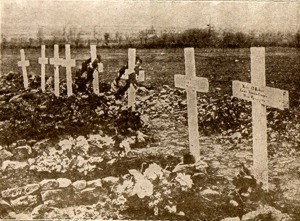
British Royal Red Cross
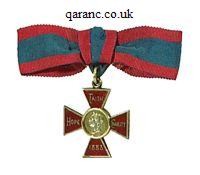
Lydia Lewis
Army Nurse Corps
Hancock County, Indiana
Served in Rouen, Nice & Menton, France. Decorated by King George, British Royal Red Cross, 2nd Class
The Royal Red Cross medal was introduced to Military Nursing by Royal Warrant by Queen Victoria on 27 April in 1883 which was St George's Day. The decoration is awarded to army nurses for exceptional services, devotion to duty, and professional competence in British military nursing. Queen Victoria wanted a special award for the distinguished service by women nursing sisters in South Africa.
The Royal Warrant said that the Royal Red Cross medal be given:
upon any ladies, whether subjects or foreign persons, who may be recommended by Our Secretary of State for War for special exertions in providing for the nursing of sick and wounded soldiers and sailors of Our Army and Navy. http://www.qaranc.co.uk/royalredcross.php
Adda Frances Goodwin
American Red Cross
Henry County, Indiana
"Every doughboy, every Tommy, every Poilu, every Wop that I talked with didn't want to fight. Even the seven Boche prisoners who did all the menial labor around our canteen didn't know what it was all about. Time: 11 PM, August 1918, place: SS Metagama, eastbound in a convoy. A crickety dame, hair in paper curlers, soaking wet nightgown, arms waving, came screaming up the grand stairway into the lounge. 'We've been hit! We're sinking! A big wave had hit the porthole directly above her bunk and knocked it open. Gallons of water poured in.
The next night 30 British destroyers came out to our convoy. As we passed the safety nets, the ship suddenly turned from utter darkness into a blaze of light.
Dulcie Hummel
Nurse
Whitley County, Indiana
"While we were reading about terrible atrocities abroad and in our ears were still ringing the shouts of 'He kept us out of the war", we were hurled dizzily into the depths of war in sailed over the seas singing 'I don't know what the war is about, but I guess, by heck, I'll soon find out!' but I guess there were some of us who never did find out... I seem to have no recollection of what was happening in civil life after I joined the ranks. In camp, the boys were, most of them, young and irked by the monotony of training and champing at the bit and eager for action, an order to the port of embarkation was good news. Nor did they shirk when they got there. To see the way they laughed at their pain and joked about their maimed limbs, one knew that they took it, going 'over the top', with their chins up. they were brave lads, everyone... it was a great war, and I'm glad I was there.
Margaret Dugan
Army Nurse Corps
Clark County, Indiana
"It was a wonderful opportunity for service, and I'm happy to have had that privilege."
Graves of Nurses who died in France
Nurses on the front lines tending to gassed soldiers
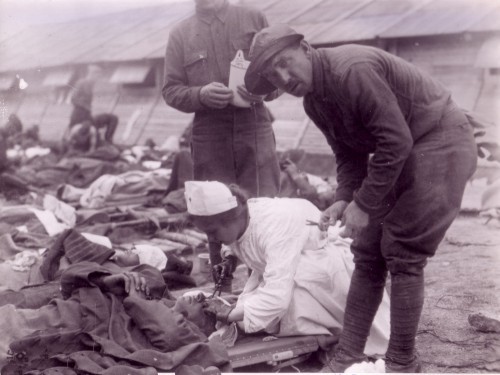
America's War for Humanity
Sacrifice:
More than 400 military women died while serving their country during World War I. The vast majority of these women were Army and Navy nurses who died from influenza, which they contracted while nursing soldiers and sailors with the disease. Millions of people around the world died in the flu epidemic of 1918-1919. The disease was virulent and highly contagious; so military personnel living and working in crowded port towns and Army camps were especially vulnerable. Because no antibiotics were available to fight the disease, it often turned into pneumonia, and those who contracted it had a high casualty rate. See:Influenza
During World War I, Army and Navy Nurses, although official members of the armed forces had no rank – they were neither officers nor enlisted personnel – simply nurses.
The following is a listing of Women from the State of Indiana who died while in service in all wars.
The majority of Women listed served during World War 1, but the list also included women of WWII through Desert Storm.
This list is included to honor all of those who lost their lives in service.
Kate B. Stansberry of Indianapolis, Indiana served as a nurse (contract nurse DAR) during the Spanish American War, died November 1898 Jacksonville, Florida. Buried Crown Hill Cemetery, Indianapolis, Indiana.
Flossie Esther Brownlee, of Farmersburg Indiana, served in the Army Nurse Corps during World War I, died October 21, 1918, in New York City.
Hannah Lora Burden of Inwood, Indiana, served in the Army Nurse Corps during World War I died on October 26, 1918, at Camp Sherman Ohio of pneumonia.
Sister M. Camilla of Lafayette, Indiana served as an Army Nurse during World War I. She died on November 29, 1918, at St. Elizabeth Hospital in Lafayette of influenza.
Florence Leclare of Indianapolis, Indiana served as an Army Nurse during World War I. She died on October 8, 1918, at Camp Devens Massachusetts of pneumonia.
Flora Ruth of Indianapolis Indiana served as an Army Nurse during World War I. She died on October 2, 1918, at Camp Pike, Arkansas.
Rose Rapp of Jeffersonville, Indiana served as an Army Nurse overseas with the American Expeditionary Force in France during World War I. She died on October 4, 1918.
Crystal McCord of Washington, Indiana served as an Army Nurse overseas with the American Expeditionary Force in France during World War I. She died on December 18, 1918.
Ethel Leach of Fairmont, Indiana served as an Army Nurse during World War I. She died on October 1, 1918, at Edgewood Arsenal, Maryland.
Grace Copland of Lebanon, Indiana served as an Army Nurse overseas with the American Expeditionary Force in France during World War I. She died on October 31, 1918.
Lettie May Berry of Franklin, Indiana served as an Army Nurse overseas with the American Expeditionary Force at Base Hospital # 32 in France during World War I. She died on December 30, 1917.
(Note: See Base Hospital 32, she is listed as the first American nurse who died in overseas service)
Grace Buell of Roanoke, Indiana served with the Army Nurse Corps overseas in France with the American Expeditionary Force at Base Hospital # 32. She died on October 8, 1918.
Patricia Byron of Fort Wayne, Indiana served in the Army Nurse Corps during World War I. She died on March 28, 1918, at Camp MacArthur, Texas.
Margaret Hamilton of Ninevah, Johnson County, Indiana served in the Army Nurse Corps during World War I with American military medical personnel overseas at General Hospital #23, a British Hospital near Etaples, France. She died on October 22, 1915.
Grace Coulter of Livonia, Indiana was working in the Marine Hospital at Louisville Kentucky when she died on September 18, 1920.
Julia Antic, a Navy Nurse from New Castle, Indiana during World War II, died from unknown causes.
WWII Army Nurse Ruth Gardiner, a 2nd Lt. from Indianapolis, Indiana, was serving as a flight nurse when the C-47 she was on crashed ten miles north of Nanak, Alaska on July 27, 1943.
WWII Army Nurse Catherine Price, a 2nd Lt. from North Liberty, Indiana was a flight nurse with the 817 Medical Air Evacuation Squadron when she died on July 26, 1944. Lt. Price was aboard a C-54 filled with patients being evacuated from Europe during the Normandy campaign.
WWII 2nd Lt. Mafaida Arney of Terre Haute, Indiana, an Army Nurse died in a plane crash on May 22, 1943, at Peterson Army Airfield near Colorado Springs, Colorado. She was on a routine night training flight for air force personnel and flight nurses. The aircraft crashed and burned shortly after take-off and all military personnel aboard died.
2nd Lt. Elizabeth Jane Howren, an Army flight nurse from Newcastle, Indiana died on February 24, 1944, while evacuating patients from Sicily to North Africa. The aircraft crashed into a mountain near Gela-Vittoria Sicily in bad weather.
WWII Private Flossie Flannery, a native of Muncie, Indiana was serving in the Women’s Army Corps during World War II when the aircraft she was aboard crashed off Derwin Point, Africa on May 30, 1945. Flannery and seventeen other enlisted women were flying from Africa to new assignments in Europe.
WWII Tech 5 Edith Ballinger, a WAC from Hartford City, Blackford County, Indiana was killed on September 30, 1943, in an air crash at Maxton Field, near Laurinburg North Carolina.
WWII Private 1st Class Rita McCarthy of Gary, Indiana died on April 11, 1943, of causes unknown.
Vietnam: Mary Klinker, of Lafayette, Indiana, a Captain with the Air Force Nurse Corps, died on April 4, 1975, when an aircraft evacuating Vietnamese children to the States crashed on take-off in Vietnam during Operation Baby Lift.
Desert Storm: Lorraine Kerstin Lawton, West Lafayette, Indiana United States Army, 2nd Lt, Desert Storm, July 10, 1991.